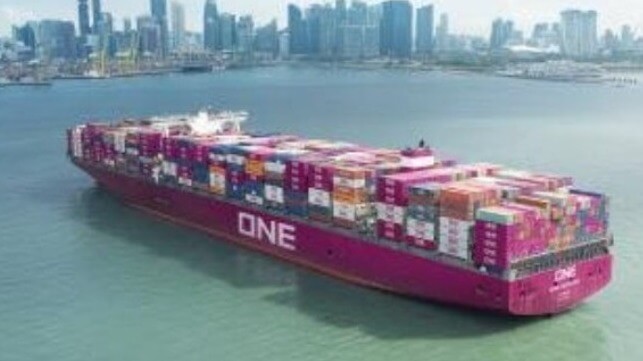ONE Maps Growth Strategy Calling for $20B in Investments by 2030

Bolstered by its strong performance in its first four years of operations and the record profitability for the container shipping industry in 2021, Ocean Network Express (ONE) detailed an aggressive growth plan for the remainder of this decade. The alliance formed by Japanese carriers in 2017, plans to invest more than $20 billion in its fleet and operations by 2030.
Speaking in an online briefing, Jeremy Nixon, CEO of ONE, highlighted the company's rapid development and success in its first four years of operation. He noted that they had been profitable since 2019, a year after beginning operation and today operates 156 weekly services to 120 countries.
In 2021, Nixon highlighted that ONE achieved a pre-tax profit margin of 53 percent placing it at the top of the industry and ahead of many larger competitors. He said the industry averaged a margin of around 40 percent in 2021. “That indicates we are in the right place against our competitors, even though some of them are much larger than us.”
He noted the turbulent market saying that he believes the pandemic-related disruptions are not over and in the short-term, they expect further uncertainty from the pandemic, the invasion of Ukraine, and inflationary pressures. “Container demand is still forecast to grow supported by strong fundamentals such as population increase, infrastructure development, and global supply chain requirements.”
Part of the strategy for the future calls for building the company’s fleet both through newbuilds and an expanded charter program. Nixon noted that three-quarters of the current fleet was on charter from NYK, Mitsui O.S.K., and K Line, which combined their container operations to establish ONE in 2017. His strategy is to expand the company’s fleet while he expects ships from the three founders will decline to around a quarter of the total fleet.
“We are now moving into the phase where we are starting to make our own orders as ONE, our own newbuilds and investment decisions,” said Nixon including the mix between charters and construction. Between 2020 and 2024 the company has commitments to add 38 vessels with a total capacity of 520,000 TEU. The ships on long-term charters range in size from 7,000 to 24,000 TEU.
By 2030, Nixon reports that they will contract for a total capacity of 1.2 million TEU, but approximately half of that will be replacements for existing capacity. Alphaliner’s ranking shows that ONE currently operates 208 ships with a total capacity of just over 1.5 million TEU, making it the sixth largest carrier. Going forward Nixon expects they will annually invest in 150,000 TEU of capacity.
The fleet investments will be made based on a green strategy and the company’s commitment to accelerate decarbonization to reach net-zero emissions by 2050. Their goal is to reduce Scope 1 emissions from 2008 levels by 70 percent per TEU km by 2030 and reach net-zero GHG by 2050. To achieve these goals, ONE is targeting gaining its first AiP for zero-emission vessels by 2023 and will also study a range of new green technologies including carbon capture and storage. They expect to deploy their first alternative fuel ship by 2030.

that matters most
Get the latest maritime news delivered to your inbox daily.
While the strategy for ONE is to continue to focus on the shipping sector as opposed to competitors that are moving to become logistics providers, ONE expects as much as half of its investments will go to terminal acquisitions and technologies including digitalization. They expect to acquire terminals, including assets from the three founding companies, to create greater market efficiencies.
The mid-term strategy for the business looks to combine economies of scale and operational efficiencies to maintain industry-leading profitability and produce a 10 percent return of equity for investors.
